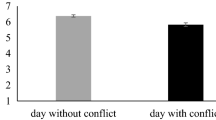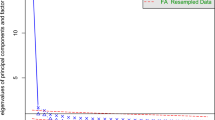Abstract
Our goal was to investigate whether systematic differences exist in how couples discuss sexual versus nonsexual conflicts in their relationships and to explore the nature of these differences. We compared sexual and nonsexual conflict discussions on two key dimensions of interpersonal behavior: warmth and dominance. Past theoretical work suggests that there are unique barriers to sexual communication that lead partners to perceive such communication as being more threatening to the relationship and to the self (Metts & Cupach, 1989). Empirical findings have supported this perspective by demonstrating that sexual communication tends to be avoided by couples (e.g., Byers, 2011). Extending this notion further, we reasoned that relationship partners should behave in ways to mitigate the increased perceived threat associated with sexual communication, leading to observable differences in how couples navigate sexual versus nonsexual relationship conflicts. We recruited a sample of 115 couples in established relationships and asked each couple to engage in two recorded interactions: one sexual and one nonsexual conflict discussion. Subsequently, each partner was coded continuously on the two dimensions of warmth and dominance. We found a number of differences in how couples discussed sexual versus nonsexual conflicts. Further, couples reported higher levels of anxiety in advance of sexual, as compared to nonsexual, conflict discussions. However, anxiety did not mediate the observed differences in communication. The theoretical and clinical implications of these findings are discussed.


Similar content being viewed by others
References
Ahlborg, T., Dahlof, L.-G., & Hallberg, L. R.-M. (2005). Quality of the intimate and sexual relationship in first-time parents six months after delivery. Journal of Sex Research, 42(2), 167–174.
Anderson, M., Kunkel, A., & Dennis, M. R. (2011). “Let’s (not) talk about that”: Bridging the past sexual experiences taboo to build healthy romantic relationships. Journal of Sex Research, 48(4), 381–391.
Beach, S. R., & Broderick, J. E. (1983). Commitment: A variable in women’s response to marital therapy. American Journal of Family Therapy, 11(4), 16–24. doi:10.1080/01926188308250143.
Bradbury, T. N., & Karney, B. R. (2010). Intimate relationships. New York, NY: Norton.
Byers, E. S. (2011). Beyond the birds and the bees and was it good for you?: Thirty years of research on sexual communication. Canadian Psychology (Psychologie Canadienne), 52(1), 20–28.
Byers, E. S., & Demmons, S. (1999). Sexual satisfaction and sexual self-disclosure within dating relationships. Journal of Sex Research, 36(2), 180–189.
Carson, R. C. (1969). Interaction concepts of personality. Chicago: Aldine.
Clark, M. S., Mills, J. R., & Corcoran, D. M. (1989). Keeping track of needs and inputs of friends and strangers. Personality and Social Psychology Bulletin, 15(4), 533–542.
Conte, H. R., & Plutchik, R. (1981). A circumplex model for interpersonal personality traits. Journal of Personality and Social Psychology, 40(4), 701–711.
Cundiff, J. M., Smith, T. W., Butner, J., Critchfield, K. L., & Nealey-Moore, J. (2015). Affiliation and control in marital interaction: Interpersonal complementarity is present but is not associated with affect or relationship quality. Personality and Social Psychology Bulletin, 41(1), 35–51.
Day, L. C., Muise, A., Joel, S., & Impett, E. A. (2015). To do it or not to do it? How communally motivated people navigate sexual interdependence dilemmas. Personality and Social Psychology Bulletin, 41(6), 791–804.
Diamond, L. M. (2013). ”Where’s the sex in relationship research”. Let’s talk about sex: Multidisciplinary discussions. Sydney: Cape Breton University.
English, T., John, O. P., Srivastava, S., & Gross, J. J. (2012). Emotion regulation and peer-rated social functioning: A 4-year longitudinal study. Journal of Research in Personality, 46(6), 780–784.
Frank, E., Anderson, C., & Rubinstein, D. N. (1978). Frequency of sexual dysfunction in normal couples. New England Journal of Medicine, 299(3), 111–115.
Gross, J. J., & John, O. P. (2003). Individual differences in two emotion regulation processes: Implications for affect, relationships, and well-being. Journal of Personality and Social Psychology, 85(2), 348–362.
Heavey, C. L., Layne, C., & Christensen, A. (1993). Gender and conflict structure in marital interaction: A replication and extension. Journal of Consulting and Clinical Psychology, 61(1), 16–27.
Horowitz, L. M., Wilson, K. R., Turan, B., Zolotsev, P., Constantino, M. J., & Henderson, L. (2006). How interpersonal motives clarify the meaning of interpersonal behavior: A revised circumplex model. Personality and Social Psychology Review, 10(1), 67–86.
Kiesler, D. J. (1983). The 1982 Interpersonal Circle: A taxonomy for complementarity in human transactions. Psychological Review, 90, 185–214.
Kiesler, D. J. (1996). Contemporary interpersonal theory and research: Personality, psychopathology, and psychotherapy. New York: Wiley.
Lavner, J. A., & Bradbury, T. N. (2012). Why do even satisfied newlyweds eventually go on to divorce? Journal of Family Psychology, 26(1), 1–10.
Lizdek, I., Sadler, P., Woody, E., Ethier, N., & Malet, G. (2012). Capturing the stream of behavior: A computer-joystick method for coding interpersonal behavior continuously over time. Social Science Computer Review, 30(4), 513–521.
MacNeil, S., & Byers, E. S. (1997). The relationships between sexual problems, communication, and sexual satisfaction. Canadian Journal of Human Sexuality, 6(4), 277–283.
MacNeil, S., & Byers, E. S. (2005). Dyadic assessment of sexual self-disclosure and sexual satisfaction in heterosexual dating couples. Journal of Social and Personal Relationships, 22(2), 169–181.
MacNeil, S., & Byers, E. S. (2009). Role of sexual self-disclosure in the sexual satisfaction of long-term heterosexual couples. Journal of Sex Research, 46(1), 3–14.
Metts, S., & Cupach, W. R. (1989). The role of communication in human sexuality. In K. McKinney & S. Sprecher (Eds.), Human sexuality: The societal and interpersonal context (pp. 139–161). Westport, CT: Ablex Publishing.
Muthen, L. K., & Muthen, B. O. (1998–2013). Mplus user’s guide (6th ed.). Los Angeles, CA: Author.
Purnine, D. M., & Carey, M. P. (1997). Interpersonal communication and sexual adjustment: The roles of understanding and agreement. Journal of Consulting and Clinical Psychology, 65(6), 1017–1025.
Rehman, U. S., Janssen, E., Newhouse, S., Heiman, J., Holtzworth-Munroe, A., Fallis, E., & Rafaeli, E. (2011). Marital satisfaction and communication behaviors during sexual and nonsexual conflict discussions in newlywed couples: A pilot study. Journal of Sex and Marital Therapy, 37(2), 94–103.
Sadler, P., Ethier, N., Gunn, G. R., Duong, D., & Woody, E. (2009). Are we on the same wavelength? Interpersonal complementarity as shared cyclical patterns during interactions. Journal of Personality and Social Psychology, 97(6), 1005–1020.
Sanford, K. (2003). Problem-solving conversations in marriage: Does it matter what topics couples discuss. Personal Relationships, 10(1), 97–112.
Simon, W., & Gagnon, J. H. (1986). Sexual scripts: Permanence and change. Archives of Sexual Behavior, 15(2), 97–120.
Theiss, J. A., & Estlein, R. (2014). Antecedents and consequences of the perceived threat of sexual communication: A test of the relational turbulence model. Western Journal of Communication, 78(4), 404–425.
Wiggins, J. S. (1996). An informal history of the interpersonal circumplex tradition. Journal of Personality Assessment, 66(2), 217–233.
Williamson, H. C., Hanna, M. A., Lavner, J. A., Bradbury, T. N., & Karney, B. R. (2013). Discussion topic and observed behavior in couples’ problem-solving conversations: Do problem severity and topic choice matter? Journal of Family Psychology, 27(2), 330–335.
Acknowledgements
This research was supported by a grant from the Social Sciences and Humanities Research Council of Canada awarded to Uzma Rehman.
Author information
Authors and Affiliations
Corresponding author
Ethics declarations
Conflict of interest
Uzma S. Rehman, Ivana Lizdek, Erin E. Fallis, and Siobhan Sutherland declare that they have no conflict of interest.
Ethical approval
All procedures performed in studies involving human participants were in accordance with the ethical standards of the institutional and/or national research committee and with the 1964 Declaration of Helsinki and its later amendments or comparable ethical standards.
Informed consent
Informed consent was obtained from all individual participants included in the study.
Rights and permissions
About this article
Cite this article
Rehman, U.S., Lizdek, I., Fallis, E.E. et al. How Is Sexual Communication Different from Nonsexual Communication? A Moment-by-Moment Analysis of Discussions Between Romantic Partners. Arch Sex Behav 46, 2339–2352 (2017). https://doi.org/10.1007/s10508-017-1006-5
Received:
Revised:
Accepted:
Published:
Issue Date:
DOI: https://doi.org/10.1007/s10508-017-1006-5




